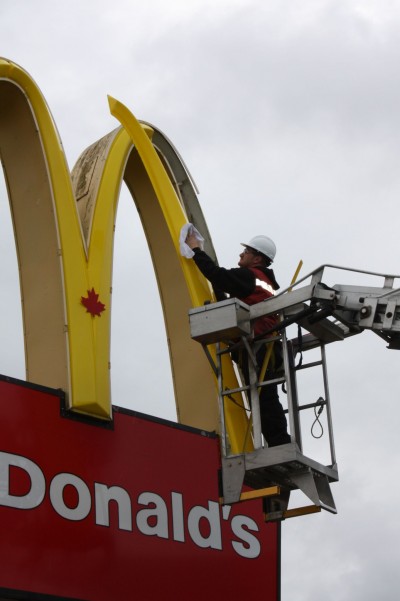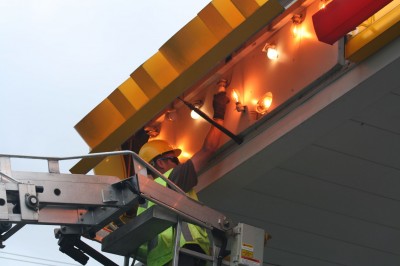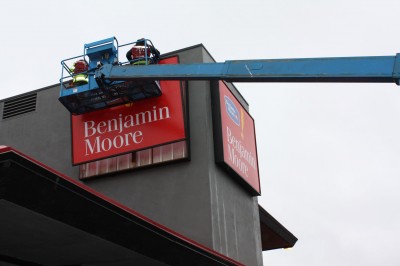Spring and summer cleaning
by Matthew | 1 July 2012 8:30 am
 [1]
[1]Photos courtesy Chris’s Sign & Lighting Service
By Chris and Kim Davies
Crews installing and servicing outdoor signs have seen many changes over the years, as the sector has shifted from wooden ladders, scaffolding and neon to safer and more efficient personnel lifts, bucket trucks and light-emitting diode (LED) retrofits. Similarly, an increasing number of crews have been certified under occupational health and safety (OHS) accreditation programs, such as the Certificate of Recognition Program (COR), and are now achieving zero-accident ratings.
Servicing neon used to be a major source of work in the sign industry, but today, rebates are available from provincial organizations like BC Hydro for converting signs from neon to LED-based illumination, which is more energy-efficient, can be installed more safely and lasts longer before maintenance is required. Many businesses are taking advantage of these incentives. Sign companies are also encouraged to recycle their used lamps, ballasts and transformers.
There is also a need to keep older signs in top condition. After the winter, many signs are covered in dirt and grime, so the spring and summer are the best seasons for a wash program. Not only do dirty signs make a business appear old and unkempt, with the potential to drive customers to the competition, but the wash program is also an opportunity for re-lamping as necessary, along with other maintenance work.
This is a chance both to reconnect with previous clients and to keep a close relationship with ongoing contract clients. It is a good idea to take photos of those signs in most desperate need of being washed and brightened up, then showcase to customers what work needs to be done.
Indeed, this is also a chance to offer sign upgrades and lighting conversions, introducing customers to the benefits of LEDs, including fewer maintenance calls in the future.
An eight-step program
Technicians carrying out a spring or summer wash program should follow these steps:
1. Secure the job site for safety.
Roping off a designated area will keep pedestrians out of danger, while also providing the necessary space so the crew can work safely.
 [2]
[2]To ensure uniform sign illumination, all bulbs should be replaced at the same time.
2. Remove components as needed.
By removing all hardware, brackets, exterior frames, panels and old lighting, the crew can access even the hardest-to-reach corners of the sign, for the most through cleaning possible.
3. Inspect and repair electrical components.
To prevent any hazards relating to the sign, it is important to make sure all electrical components—including wiring, sockets, ballasts and transformers—are in strong working condition. Due to the elements, these components can otherwise deteriorate over time and become faulty.
4. Scrub, scrub, scrub.
Taking time to thoroughly clean the full interior and exterior of the sign, beyond just the main sign face and frame, is extremely important in maintaining the image of the business. The sign, after all, is the first impression for customers.
5. Install new lighting as needed.
To achieve the best overall sign appearance, it is important to ensure uniform illumination. So, all bulbs should be replaced at the same time. This will also help reduce the frequency of future service calls.
6. Replace the face.
When checking all of the sign components are secure and fitting properly, crews frequently find loose bolts and bent or damaged frames, as a result of severe weather damage. It may well be time to replace the sign’s face, frame, hardware and brackets.
 [3]
[3]If there has been damage during the winter, it may be time to replace the entire sign face.
7. Clean up after yourself.
The job site should be left in the same condition as it was before or better. Besides the clean and new appearance of the sign itself, it should look like the crew was never there, with no debris left behind or mess from the sign servicing process.
8. Write down recommendations.
During the sign cleaning process, crews might notice other issues worth bringing to the attention of the client. These should be noted in writing, along with advice for further extending the useful life of the sign and for reducing maintenance costs. This is an important step for keeping in contact with the client.
Chris Davies is owner and Kim Davies is social media manager for Chris’s Sign & Lighting Service in Langley, B.C. For more information, contact Chris via e-mail at cdavies@chris-signs.com[4] or visit www.chris-signs.com[5].
- [Image]: http://www.signmedia.ca/wp-content/uploads/2014/02/McDonalds-Walnut-grove-026.jpg
- [Image]: http://www.signmedia.ca/wp-content/uploads/2014/02/IMG_4395_JPG.jpg
- [Image]: http://www.signmedia.ca/wp-content/uploads/2014/02/044.jpg
- cdavies@chris-signs.com: mailto:%20cdavies@chris-signs.com
- www.chris-signs.com: http://www.chris-signs.com
Source URL: https://www.signmedia.ca/spring-and-summer-cleaning/